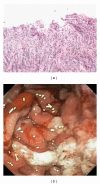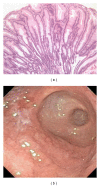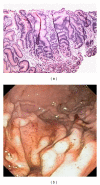Atypical Clinical and Diagnostic Features in Ménétrier's Disease in a Child
- PMID: 22606420
- PMCID: PMC3350056
- DOI: 10.1155/2011/480610
Atypical Clinical and Diagnostic Features in Ménétrier's Disease in a Child
Abstract
Ménétrier's disease is one of the rarest protein-losing gastropathies in childhood. It is characterized clinically by non-specific gastrointestinal symptoms and edema, biochemically by hypoalbuminemia, and pathologically by enlarged gastric folds. In adults, this disease can be devastating with significant morbidity and mortality. In childhood, it is a self-limiting, transient and benign illness. Its treatment is largely supportive with total parenteral nutrition (TPN) while oral intake is encouraged. Acute onset of vomiting in healthy school age children can be initially explained by acute viral gastroenteritis. However, persistent vomiting associated with hematemesis and severe abdominal pain should warrant further work-up. This case report illustrates a self-limiting and rare cause of protein-losing enteropathy called Ménétrier's disease that presented with several variant clinical features not typically described in association with this entity.
Figures



Similar articles
-
Co-Infection with Cytomegalovirus and Helicobacter pylori in a Child with Ménétrier's Disease.Pediatr Gastroenterol Hepatol Nutr. 2013 Jun;16(2):123-6. doi: 10.5223/pghn.2013.16.2.123. Epub 2013 Jun 30. Pediatr Gastroenterol Hepatol Nutr. 2013. PMID: 24010116 Free PMC article.
-
A case of Menetrier's disease without Helicobacter pylori or hypoalbuminemia.Int J Surg Case Rep. 2015;17:58-60. doi: 10.1016/j.ijscr.2015.10.025. Epub 2015 Oct 27. Int J Surg Case Rep. 2015. PMID: 26551554 Free PMC article.
-
Menetrier's disease (protein-losing gastropathy) in a child with acute lymphoblastic leukemia.Int J Pediatr Adolesc Med. 2019 Mar;6(1):38-40. doi: 10.1016/j.ijpam.2019.01.002. Epub 2019 Jan 7. Int J Pediatr Adolesc Med. 2019. PMID: 31304227 Free PMC article.
-
Protein-losing gastropathy associated with cytomegalovirus in two sisters - Case reports and review of the literature.Arch Pediatr. 2019 May;26(4):232-235. doi: 10.1016/j.arcped.2019.03.005. Epub 2019 Apr 4. Arch Pediatr. 2019. PMID: 30954365 Review.
-
[Protein-losing gastroenteropathy (Ménétrier's disease) in childhood: a report of 3 cases].Pediatr Med Chir. 1996 May-Jun;18(3):269-73. Pediatr Med Chir. 1996. PMID: 8966127 Review. Italian.
Cited by
-
The Great Mimicker of Gastric Cancer: A Case Report of Ménétrier's Disease.Cureus. 2024 Feb 27;16(2):e55076. doi: 10.7759/cureus.55076. eCollection 2024 Feb. Cureus. 2024. PMID: 38550419 Free PMC article.
References
-
- Menetrier P. Des polyadenomes gastriques et de leurs rapports avec le cancer de l’estomac. Archives de Physiologie Normale et Pathologique. 1888;32:236–262.
-
- Blackstone MM, Mittal MK. The edematous toddler: a case of pediatric Ménétrier disease. Pediatric Emergency Care. 2008;24(10):682–684. - PubMed
-
- Cieslak TJ, Mullett CT, Puntel RA, Latimer JS. Menetrier’s disease associated with cytomegalovirus infection in children: report of two cases and review of the literature. Pediatric Infectious Disease Journal. 1993;12(4):340–343. - PubMed
-
- Gandhi M, Nagashree S, Murthy V, Hegde R, Viswanath D. Menetrier’s disease. Indian Journal of Pediatrics. 2001;68(7):685–686. - PubMed
-
- Raic F, Votava A, Tambic L, Manojlovic S. Hypertrophic gastritis in association with sepsis and death in a two-month-old infant. Journal of Pediatric Gastroenterology and Nutrition. 1988;7(3):461–465. - PubMed
Publication types
LinkOut - more resources
Full Text Sources
Research Materials

